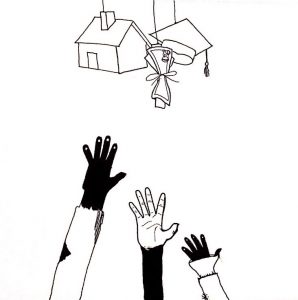Social Anxieties: Do not assume racial segregation to be only a thing of the past
As a thought experiment, think about a world nearly identical to ours. Same history, same geography, same people, with only one difference: All human beings have eradicated racism from their consciousness instantaneously. In this hypothetical world, people no longer believe in racial stereotypes or subscribe to notions of their own racial superiority. Unfortunately, even in this idealist world — with no racist people — we’d still have a racist society.
Racism is often mistaken as a moral disease afflicting bad cops, Trumpsters and Paula Deen. But in reality, the issue is far more structural.
In 1860, at the start of the final decade of slavery, 12.6 percent of the U.S. population was in chains. After the Emancipation Proclamation and the 13th Amendment, slaves were released into terrible conditions, which later put them at a significant systemic disadvantage. The end of slavery released over four million black Americans into poverty and discrimination.
For generations, black people were denied equal rights, education, housing, healthcare and basic empathy from a country dominated by white people. With the Plessy v. Ferguson decision in 1896, the federal government endorsed the principle of “separate but equal.” This precedent allowed for racial segregation and isolation of an entire population that was never given the chance to fully sustain itself. By the time “legal” segregation officially — although arguably — ended in 1964 with the passage of the Civil Rights Act and the alleged death of Jim Crow segregation, American people of color were already thrown into a deep hole of economic scarcity and inflexibility.
Fifty-four years after the “end of segregation,” black Americans are still severely disadvantaged in nearly every metric sense, and in many cases, to a more severe extent than they were in 1964. For example, according to a 2016 study by the Urban Institute, the average white family’s total wealth is $919,000, while the average black family’s wealth is only $140,000. The gap is seven times larger than it was in 1963.
The racial wealth gap is compounded by existing racial segregation. Nationwide, 75 percent of black students attend schools made mostly of people of color and 38 percent attend schools which have a white student population of 10 percent or lower. This segregation has been worsening since the 1990s, erasing much of the progress created by Brown v. Board of Education in 1954. This segregation is harmful because the principle of “separate but equal” remains untrue and unjust, just as it was during the Jim Crow era.
According to Beverly Daniel Tatum, president emerita of Spellman College, “schools with concentrated poverty and racial segregation are more likely to have less-experienced teachers, high levels of teacher turnover, inadequate facilities, and fewer classroom resources.” These schools’ lack of effectiveness limits the economic potential of their homogenous student body, as well as the similarly comprised student body that follows — perpetuating a vicious cycle of racially slanted poverty.
The worsening cycle of racist poverty proves a need for increased economic mobility, particularly amongst people of color, for which research has proven integration to be key. A long-term comprehensive study conducted by researchers at Harvard University and UC Berkeley found hometown density to be a major factor in determining the ability of a poor individual to escape poverty in his or her lifetime. Generally, the denser an area is, the less isolated its local economies are, allowing for more movement and interaction between weaker and stronger economies, increasing overall demand within communities that need it.
A complete lack of density, particularly in areas where poverty is concentrated, is why Los Angeles County ranks in the bottom 7th percentile of U.S. counties in economic mobility. Los Angeles’ famed sprawl is also notoriously segregated, with 60 percent of Angelenos of color living in communities where few whites are present, according to the 2010 census. Data suggests that this segregation and the consequent economic staticity of minorities are a result of not only our country’s racist history but also its housing and zoning policies.
The L.A. City Council’s decision to incentivize denser construction along the Metro Expo line is a decision that will hopefully result in an uptick in affordable housing that lies in close proximity to more high-income residents. If the council diligently accounts for factors such as demand inflation with protections for low-income residents, this move could signify a trend that puts Los Angeles on track to become a
city where regardless of one’s race or economic background, everyone is granted a chance to be self-sustaining.
Fighting racism is more than fighting racists. It’s not enough to exorcize oneself of hatred, but one needs to maintain an academic diligence to the progress of those that history neglected through both direct and indirect discrimination. As long as Los Angeles and other cities remain this segregated, the process of ending American racism is stalled.
Nathaniel Hyman is a freshman majoring in philosophy, politics and law. His column,“Social Anxieties,” generally runs every other Tuesday.

